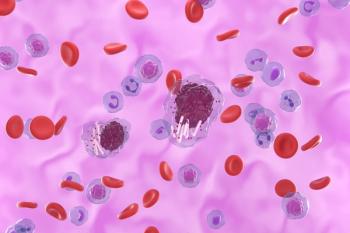
Tarlatamab Improves SCLC Outcomes After Platinum Chemotherapy
Key Takeaways
- Tarlatamab targets DLL3 and CD3, improving survival in SCLC patients post-platinum-based chemotherapy.
- Phase 3 trial showed tarlatamab's median overall survival of 13.6 months versus 8.3 months with chemotherapy.
Median overall survival was 5 months longer in patients with small cell lung cancer (SCLC) who received tarlatamab instead of chemotherapy after progression following platinum-based chemotherapy.
Tarlatamab (Imdelltra; Amgen) led to improved survival outcomes compared with chemotherapy in patients with
Tarlatamab is a bispecific T-cell engager that targets both delta-like ligand 3 (DLL3), which is expressed on the surface of cancer cells in most patients, and CD3, which is found on T-cells. Last year, the therapy was
That patient group is important, the authors noted, because despite therapeutic advances, survival outcomes remain poor.1
“Although most patients’ tumors respond to frontline platinum-based chemotherapy, etoposide, and programmed death ligand 1 (PD-L1) inhibitor therapy, the median overall survival remains approximately 12 months,” the authors explained. Patients whose tumors are resistant to platinum-based chemotherapy or who experience brain metastases face particularly poor outcomes.
The standard second-line therapy in SCLC is topotecan (Hycamtin; Novartis), and in some countries lurbinectedin (Zepzelca; Jazz Pharmaceuticals) and amrubicin (Calsed; Celgene) are available. However, Rudin and colleagues said the existing chemotherapeutic options have limited benefits and significant toxicities.
“Poor outcomes coupled with challenging side-effect profiles underscore the need for better therapies in the context of second-line treatment,” they wrote.
In a
The new study included phase 3 data comparing tarlatamab’s safety and efficacy to that of chemotherapy in patients who experienced progression during or after a previous line of platinum-containing chemotherapy.1
The open-label trial included 509 participants, 254 of whom were randomized to the tarlatamab arm. The median age of participants was 65 years. Most (71%) had previously received PD-L1 or PD-1 inhibitor therapy, and 44% had platinum-resistant disease, the investigators said.
Of the 255 patients in the chemotherapy arm, most (73%) received topotecan, 18% received lurbinectedin, and 9% received amrubicin.
Patients with brain metastases were allowed into the trial if they were asymptomatic and their condition was clinically stable. Forty-five percent of patients had current or previous brain metastases at baseline, and 35% had liver metastases. DLL3 expression was not required to be included in the trial.
For overall survival (OS), the median follow-up for the tarlatamab group was 11.2 months, and the median follow-up for the chemotherapy group was 11.7 months. The authors found that patients in the tarlatamab group had significantly longer OS, with a median of 13.6 months (95% CI, 11.1-not reached). In the chemotherapy group, the median OS was 8.3 months (95% CI, 7.0-10.2). The stratified hazard ratio for death was 0.60 (95% CI, 0.47-0.77; P < .001).
In terms of progression-free survival (PFS), the tarlatamab group showed a median PFS of 4.2 months (95% CI, 3.4-4.5), while the chemotherapy group had a median PFS of 3.7 months (95% CI, 2.9-4.2).
Turning to safety, 54% of patients in the tarlatamab group experienced grade 3 or higher adverse events, compared with 80% in the chemotherapy group. Rates of discontinuation due to adverse events were 5% and 12% in the tarlatamab and chemotherapy groups, respectively.
“Collectively, the survival benefit, toxic effects of mainly low grade, and favorable patient-reported outcomes support the use of tarlatamab as treatment for small-cell lung cancer that has progressed during or after initial platinum-based chemotherapy,” they concluded.
References
1. Mountzios G, Sun L, Cho BC, et al. Tarlatamab in small-cell lung cancer after platinum-based chemotherapy. N Engl J Med. Published online June 2, 2025. doi:10.1056/NEJMoa2502099
2. FDA grants accelerated approval to tarlatamab-dlle for extensive-stage small cell lung cancer. FDA. May 16, 2024. Accessed June 10, 2025.
3. Ahn MJ, Cho BC, Felip E, et al. Tarlatamab for patients with previously treated small-cell lung cancer. N Engl J Med. 2023;389(22):2063-2075. doi:10.1056/NEJMoa2307980
Newsletter
Stay ahead of policy, cost, and value—subscribe to AJMC for expert insights at the intersection of clinical care and health economics.









































